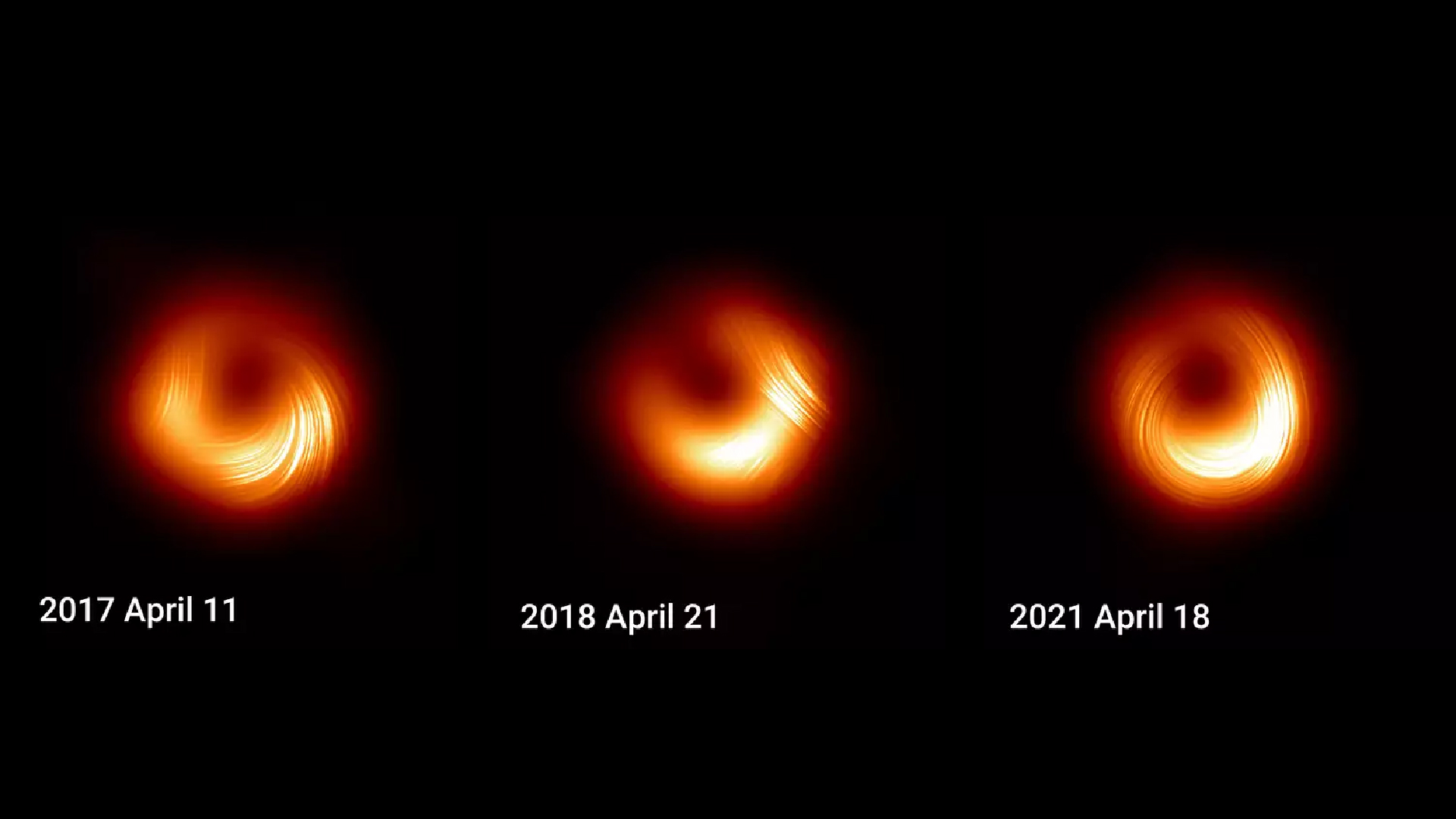First-ever black hole to be directly imaged has changed ‘dramatically’ in just 4 years, new study finds
By Elizabeth Howell
Copyright livescience

Skip to main content
Close main menu
Live Science
Sign up to our newsletter
View Profile
Search Live Science
Planet Earth
Archaeology
Physics & Math
Human Behavior
Science news
Life’s Little Mysteries
Science quizzes
Newsletters
Story archive
Skyscraper-sized asteroid flyby
Mysterious hand positions on Maya alter
Anthropologist Ella Al-Shamahi on human origins
Treasure in scorched Roman-era house
Ant clones members of another species
Don’t miss these
Black Holes
X-ray telescope finds something unexpected with the ‘heartbeat black hole’
Black Holes
Giant, cosmic ‘Eye of Sauron’ snapped staring directly at us in stunning 15-year time-lapse photo
Black Holes
Exotic ‘blazar’ is part of most extreme double black hole system ever found, crooked jet suggests
Black Holes
This supermassive black hole is eating way too quickly — and ‘burping’ at near-light speeds
Black Holes
Colossal black hole 36 billion times the mass of our sun is one of the largest ever seen in the universe
‘Ice cube’ clouds discovered at the galaxy’s center shouldn’t exist — and they hint at a recent black hole explosion
Black Holes
See the universe’s rarest type of black hole slurp up a star in stunning animation
Black Holes
Scientists think they detected the first known triple black hole system in the universe — and then watched it die
Black Holes
James Webb telescope spots earliest black hole in the known universe, looking ‘as far back as you can practically go’
Scientists may have found a powerful new space object: ‘It doesn’t fit comfortably into any known category’
Black Holes
There’s a 90% chance we’ll see a black hole explode within a decade, physicists say
Black Holes
Scientists use Stephen Hawking theory to propose ‘black hole morsels’ — strange, compact objects that could reveal new physics
Black Holes
Scientists detect most massive black hole merger ever — and it birthed a monster 225 times as massive as the sun
Black Holes
Scientists measure the ‘natal kick’ that sent a baby black hole careening through space for the first time
Black Holes
Confirmed! Black hole merger shows Stephen Hawking theory was right
Black Holes
First-ever black hole to be directly imaged has changed ‘dramatically’ in just 4 years, new study finds
Elizabeth Howell
18 September 2025
The polarization pattern around M87* — the first black hole to be directly imaged by the Event Horizon Telescope — has changed direction, and scientists aren’t sure why.
When you purchase through links on our site, we may earn an affiliate commission. Here’s how it works.
Changes in the magnetic field of the black hole M87* are visible in three images obtained in 2017, 2018 and 2021.
(Image credit: EHT Collaboration)
One of the first black holes ever imaged is even stranger than we thought, new images of its dramatically changing environment reveal.
The object, known as M87*, has experienced unexpected changes in its magnetic fields that are showing up in polarized light — meaning, light waves that are orientated in the same way (such as vertically, or horizontally).
Astronomers are closely studying the precious few images we have to learn more about the role of magnetic fields at black holes such as M87*. Ideally, one of the study co-authors told LiveScience, a “movie” of the black hole — a sequence of images taken as frequently as once or twice a week — may in the future better reveal the changes in magnetic fields, as that’s how quickly M87* evolves.
You may like
X-ray telescope finds something unexpected with the ‘heartbeat black hole’
Giant, cosmic ‘Eye of Sauron’ snapped staring directly at us in stunning 15-year time-lapse photo
Exotic ‘blazar’ is part of most extreme double black hole system ever found, crooked jet suggests
“With only three images of M87*, we’re just beginning to scratch the surface of its horizon-scale mysteries — but we’re certain that we can,” Sebastiano von Fellenberg, who was a scientist at Germany’s Max Planck Institute for Radio Astronomy (MPIfR) when the research was carried out, told Live Science in an email.
A black hole comes to light
Images of M87* were so far obtained in 2017, 2018 and 2021 by the Event Horizon Telescope (EHT) collaboration — a global network of radio telescopes that just added two new observatories to its network in Arizona and France. As its name implies, the black hole resides at the center of the galaxy Messier 87 (M87), and is located 55 million light-years from Earth.
Related: Astronomers accidentally use rare ‘double zoom’ technique to view black hole’s corona in unprecedented detail
Now EHT, in collaboration with MpiFR, is tracing the “dynamic environment” surrounding the black hole after analysis of these three images, the consortium wrote in a press release.
Sign up for the Live Science daily newsletter now
Get the world’s most fascinating discoveries delivered straight to your inbox.
Contact me with news and offers from other Future brandsReceive email from us on behalf of our trusted partners or sponsorsBy submitting your information you agree to the Terms & Conditions and Privacy Policy and are aged 16 or over.
M87* is quite massive, more than six billion times the mass of the sun. The new polarization information provides scientists with data about how the magnetic fields around it are structured, and how strong those fields are.
As the theory goes, magnetic fields at supermassive black holes are situated in a disk of plasma (superheated gas) circling the black hole. These fields spin together into “magnetic towers” full of incredible energy.
That energy in turn propels matter along jets, which are stabilized by the magnetic fields and move at close to the speed of light. The jets come from a small area surrounding the black hole, but still have a large effect on the galaxy’s star formation and energy distribution — both of which play into the galaxy’s evolution.
You may like
X-ray telescope finds something unexpected with the ‘heartbeat black hole’
Giant, cosmic ‘Eye of Sauron’ snapped staring directly at us in stunning 15-year time-lapse photo
Exotic ‘blazar’ is part of most extreme double black hole system ever found, crooked jet suggests
Von Fellenberg, who is now a fellow at the University of Toronto-based Canadian Institute for Theoretical Astrophysics, said there are two main takeaways from the work: that the polarization has a lot of variability, but that the total intensity images (topographic images) of M87* remain consistent.
“Both of these outcomes are expected to some degree,” he explained. Total intensity is related to how much gravitational potential a black hole has, which shouldn’t change much in the few years in which the images were collected.
But polarization, he added, “traces the state of the matter and magnetic field in the accretion flow — and to some extent, along the base of the jet.” As such, said von Fellenberg, “The changes we observe imply that each snapshot captures a different state of these properties, which is consistent with theoretical predictions.”
A dramatic shift
One big surprise was a polarization measure observed in 2021, called angle β₂. Compared with previous readings in 2017 and 2018, this measurement “shifts so dramatically that it no longer aligns with the electromagnetic-energy flux from previous years,” von Fellenberg said.
Or as officials put it in the press release, the polarization pattern “flipped direction” between the three images: the magnetic fields were spiraling one way in 2017, stabilizing in 2018, and then reversing in 2021.
RELATED STORIES
— Time-lapse of 1st black hole ever imaged reveals how matter swirls around it
— Monster black hole M87 is spinning at 80% of the cosmic speed limit — and pulling in matter even faster
— Astronomers spot an enormous explosion from the 1st black hole ever photographed
Scientists are trying to explain why this happened. From physics, they know that the discrepancy can only be explained if they see no additional polarization changes caused by electrons or matter along the line of sight, called external Faraday rotation.
This leaves the team with four possible explanations: a change in the underlying magnetic field structure, a change in the degree of Faraday rotation, evolving contributions from different emission regions (such as the disk or jet), or a combination of the first three factors.
Black hole quiz: How supermassive is your knowledge of the universe?
Elizabeth Howell
Live Science Contributor
Elizabeth Howell was staff reporter at Space.com between 2022 and 2024 and a regular contributor to Live Science and Space.com between 2012 and 2022. Elizabeth’s reporting includes multiple exclusives with the White House, speaking several times with the International Space Station, witnessing five human spaceflight launches on two continents, flying parabolic, working inside a spacesuit, and participating in a simulated Mars mission. Her latest book, “Why Am I Taller?” (ECW Press, 2022) is co-written with astronaut Dave Williams.
You must confirm your public display name before commenting
Please logout and then login again, you will then be prompted to enter your display name.
X-ray telescope finds something unexpected with the ‘heartbeat black hole’
Giant, cosmic ‘Eye of Sauron’ snapped staring directly at us in stunning 15-year time-lapse photo
Exotic ‘blazar’ is part of most extreme double black hole system ever found, crooked jet suggests
This supermassive black hole is eating way too quickly — and ‘burping’ at near-light speeds
Colossal black hole 36 billion times the mass of our sun is one of the largest ever seen in the universe
‘Ice cube’ clouds discovered at the galaxy’s center shouldn’t exist — and they hint at a recent black hole explosion
Latest in Black Holes
There’s a 90% chance we’ll see a black hole explode within a decade, physicists say
Scientists measure the ‘natal kick’ that sent a baby black hole careening through space for the first time
Science history: Gravitational waves detected, proving Einstein right — Sept. 14, 2015
Astronomers use rare ‘double zoom’ to view black hole corona in unprecedented detail
Confirmed! Black hole merger shows Stephen Hawking theory was right
Scientists think they detected the first known triple black hole system in the universe — and then watched it die
Latest in News
First-ever black hole to be directly imaged has changed ‘dramatically’ in just 4 years, new study finds
CDC committee votes to change measles vaccine guidance for young children
New report warns that China could overtake the US as top nation in space — and it could happen ‘in 5-10 years,’ expert claims
Jaguar in Brazil smashes record for the species’ longest documented swim
See the moon, Venus and Regulus in a rare triple conjunction tomorrow
RFK’s handpicked advisers are coming for the childhood vaccine schedule. Here’s what to know.
LATEST ARTICLES
CDC committee votes to change measles vaccine guidance for young children
First-ever black hole to be directly imaged has changed ‘dramatically’ in just 4 years, new study finds
New report warns that China could overtake the US as top nation in space — and it could happen ‘in 5-10 years,’ expert claims
Tiny ‘brains’ grown in the lab could become conscious and feel pain — and we’re not ready
How to see the moon, Venus and the bright star Regulus in an ultraclose conjunction tomorrow
Live Science is part of Future US Inc, an international media group and leading digital publisher. Visit our corporate site.
Contact Future’s experts
Terms and conditions
Privacy policy
Cookies policy
Accessibility Statement
Advertise with us
Web notifications
Editorial standards
How to pitch a story to us
Future US, Inc. Full 7th Floor, 130 West 42nd Street,
Please login or signup to comment
Please wait…



